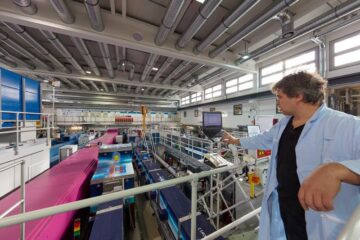Compounds activating the glmS riboswitch

Cyclohexane compounds and their use as antibiotics
Invention The present invention relates to cyclohexane compounds for the treatment of a bacterial infection, particularly for use as an antibiotic. Since the discovery of antibiotic substances and their use against microbes, bacteria have evolved to defend themselves by acquiring resistances. Especially in hospitals where bacteria are exposed to a wide array of antibacterial substances, multiresistant strains (e.g. MRSA) arose. This is why it is not only necessary to have an ongoing search for new antibiotic substances, but to also find and use new antibacterial targets enforcing new mechanisms of action. Riboswitches have appeared as one new promising target for antibacterial defence. Riboswitches are mostly found in the 5'-untranslated region of bacterial mRNA and regulate 2-4% of all bacterial genes. In the past it has been shown that metabolite analogues can be employed to trigger riboswitch function thereby modulating its regulatory character. Thus, it would be desirable to provide compounds that also target the glmS riboswitch and exhibit antimicrobial activity.
Weitere Informationen: PDF
PROvendis GmbH
Tel.: +49 (0)208/94105 10
Ansprechpartner
Dipl.-Ing. Alfred Schillert
Media Contact
Alle Nachrichten aus der Kategorie: Technologieangebote
Neueste Beiträge

Bakterien für klimaneutrale Chemikalien der Zukunft
Forschende an der ETH Zürich haben Bakterien im Labor so herangezüchtet, dass sie Methanol effizient verwerten können. Jetzt lässt sich der Stoffwechsel dieser Bakterien anzapfen, um wertvolle Produkte herzustellen, die…

Batterien: Heute die Materialien von morgen modellieren
Welche Faktoren bestimmen, wie schnell sich eine Batterie laden lässt? Dieser und weiteren Fragen gehen Forschende am Karlsruher Institut für Technologie (KIT) mit computergestützten Simulationen nach. Mikrostrukturmodelle tragen dazu bei,…

Porosität von Sedimentgestein mit Neutronen untersucht
Forschung am FRM II zu geologischen Lagerstätten. Dauerhafte unterirdische Lagerung von CO2 Poren so klein wie Bakterien Porenmessung mit Neutronen auf den Nanometer genau Ob Sedimentgesteine fossile Kohlenwasserstoffe speichern können…

















